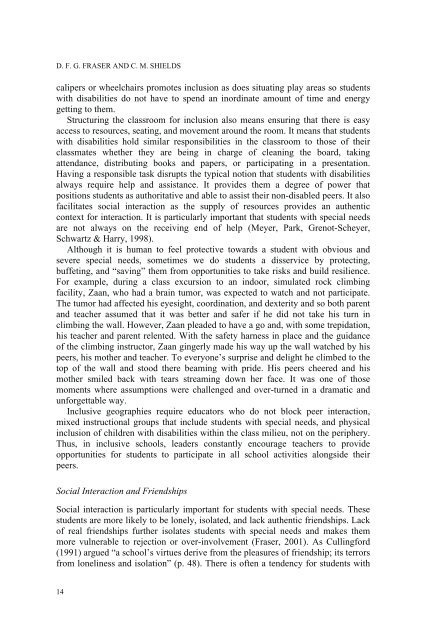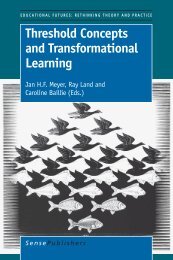Leadership for Inclusion
577-leadership-for-inclusion
577-leadership-for-inclusion
- No tags were found...
You also want an ePaper? Increase the reach of your titles
YUMPU automatically turns print PDFs into web optimized ePapers that Google loves.
D. F. G. FRASER AND C. M. SHIELDS<br />
calipers or wheelchairs promotes inclusion as does situating play areas so students<br />
with disabilities do not have to spend an inordinate amount of time and energy<br />
getting to them.<br />
Structuring the classroom <strong>for</strong> inclusion also means ensuring that there is easy<br />
access to resources, seating, and movement around the room. It means that students<br />
with disabilities hold similar responsibilities in the classroom to those of their<br />
classmates whether they are being in charge of cleaning the board, taking<br />
attendance, distributing books and papers, or participating in a presentation.<br />
Having a responsible task disrupts the typical notion that students with disabilities<br />
always require help and assistance. It provides them a degree of power that<br />
positions students as authoritative and able to assist their non-disabled peers. It also<br />
facilitates social interaction as the supply of resources provides an authentic<br />
context <strong>for</strong> interaction. It is particularly important that students with special needs<br />
are not always on the receiving end of help (Meyer, Park, Grenot-Scheyer,<br />
Schwartz & Harry, 1998).<br />
Although it is human to feel protective towards a student with obvious and<br />
severe special needs, sometimes we do students a disservice by protecting,<br />
buffeting, and “saving” them from opportunities to take risks and build resilience.<br />
For example, during a class excursion to an indoor, simulated rock climbing<br />
facility, Zaan, who had a brain tumor, was expected to watch and not participate.<br />
The tumor had affected his eyesight, coordination, and dexterity and so both parent<br />
and teacher assumed that it was better and safer if he did not take his turn in<br />
climbing the wall. However, Zaan pleaded to have a go and, with some trepidation,<br />
his teacher and parent relented. With the safety harness in place and the guidance<br />
of the climbing instructor, Zaan gingerly made his way up the wall watched by his<br />
peers, his mother and teacher. To everyone’s surprise and delight he climbed to the<br />
top of the wall and stood there beaming with pride. His peers cheered and his<br />
mother smiled back with tears streaming down her face. It was one of those<br />
moments where assumptions were challenged and over-turned in a dramatic and<br />
un<strong>for</strong>gettable way.<br />
Inclusive geographies require educators who do not block peer interaction,<br />
mixed instructional groups that include students with special needs, and physical<br />
inclusion of children with disabilities within the class milieu, not on the periphery.<br />
Thus, in inclusive schools, leaders constantly encourage teachers to provide<br />
opportunities <strong>for</strong> students to participate in all school activities alongside their<br />
peers.<br />
Social Interaction and Friendships<br />
Social interaction is particularly important <strong>for</strong> students with special needs. These<br />
students are more likely to be lonely, isolated, and lack authentic friendships. Lack<br />
of real friendships further isolates students with special needs and makes them<br />
more vulnerable to rejection or over-involvement (Fraser, 2001). As Culling<strong>for</strong>d<br />
(1991) argued “a school’s virtues derive from the pleasures of friendship; its terrors<br />
from loneliness and isolation” (p. 48). There is often a tendency <strong>for</strong> students with<br />
14




